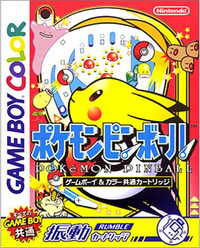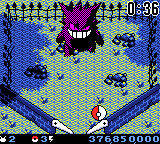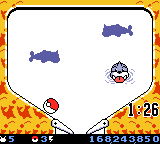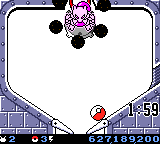Pokémon Pinball
- For other uses, see pinball.
| Pokémon Pinball ポケモンピンボール | |
|---|---|
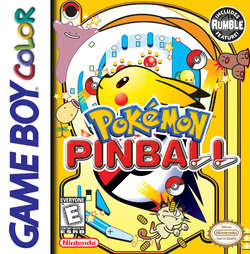 Pokémon Pinball's boxart | |
Basic info
| |
| Platform: | Game Boy Color* |
| Category: | Pinball |
| Players: | 1 |
| Connectivity: | None |
| Developer: | Jupiter Corporation |
| Publisher: | Nintendo |
| Part of: | Generation I side series |
Ratings
| |
| CERO: | A |
| ESRB: | E |
| ACB: | G |
| OFLC: | G8+ |
| PEGI: | 3+ |
| GRAC: | N/A |
| GSRR: | N/A |
Release dates
| |
| Japan: | April 14, 1999[1] |
| North America: | June 28, 1999[2] |
| Australia: | July 2000[3] |
| Europe: | October 6, 2000[4] |
| South Korea: | N/A |
| Hong Kong: | N/A |
| Taiwan: | N/A |
Websites
| |
| Japanese: | Pokémon.co.jp Nintendo.co.jp |
| English: | Pokémon.com Nintendo.com |
|
Japanese boxart
| |
Pokémon Pinball (Japanese: ポケモンピンボール Pokémon Pinball) is a spin-off pinball game for the Game Boy Color. The cartridge was unique at the time among Game Boy games in that it includes a rumble pack powered by a single AAA battery, providing force feedback in much the same way as controllers for TV consoles. As the title suggests, the gameplay is pinball-based, but with a uniquely Pokémon-inspired spin. For example, the game is divided into two tables, the Red Field and the Blue Field, named after the first paired versions released outside of Japan, each with different table designs, accessible map locations, and catchable wild Pokémon.
The game received an update/sequel on the Game Boy Advance in the form of Pokémon Pinball: Ruby & Sapphire.
Objective
The goal is to catch all the Pokémon and complete the Pokédex. Beyond that and the ever-present goal of getting a high score, there is no storyline to speak of.
Blurb
Catch 'em all with a pinball!
Discover a whole new way to collect Pokémon - by playing pinball! Hit the targets with your Poké Ball to catch and evolve Pokémon. The better you do, the more rare Pokémon you'll find! Every Pokémon you catch is automatically recorded in your Pokédex - see if you can catch all 150! Some Pokémon appear only on the Red Field or only on the Blue Field, so you'll have to play both to catch 'em all!
- The new Rumble feature makes you feel like you're playing a real pinball machine!
- Trade high scores with a friend using the built-in Infrared Communications Port (on Game Boy Color only).
- Print out your high scores with a Game Boy Printer (sold separately).
- Find the bonus stages to rack up a high score.
- Upgrade your Poké Ball to a Great Ball, Ultra Ball, or Master Ball and score even higher!
- Game Pak contains built in Rumble feature (one AAA battery included).
Acquiring Pokémon
Rather than catching Pokémon in any traditional manner, Pokémon Pinball requires players to play special game modes on the pinball table to catch and evolve their Pokémon and complete their Pokédex.
Catch 'Em Mode
In Catch 'Em Mode, the player enters by lighting up two or three "GET" lights by letting the ball pass a certain tab. If the player lights up three lights, he/she gets different Pokémon than if he/she lighted up two. When it starts, a Pokémon silhouette appears in the middle of the lower field, and the player must hit the bumpers to gradually turn all six pieces of it into color. Once that is done, the actual Pokémon appears there. Then the player must hit it three times to light up what says "CATCH!" two characters at a time, then hit it one last time to catch the Pokémon. Once the player has caught it, he/she can evolve it in Evolution Mode. It also lights up one Poké Ball out of three which lets him/her reach the next Bonus Stage. The player has two minutes to complete Catch 'em! Mode. Up to 255 Pokémon can be caught at the same time within a game: catching a 256th will result into the counter being set back to 0 and the list being blanked, but the player will receive a bonus of 1,000,000,000 points.
Evolution Mode
Evolution mode is only accessible if the player has caught at least one Pokémon in Catch 'em! Mode. The player also has to light up three "EVO" lights activated in the same way as the GET lights. The player has to hit a spot where an arrow is pointing to on the field. Then the player can choose any one of the Pokémon they have caught. Then, depending on how the Pokémon evolves, the player has to have the ball hit either an "EX" for EXP., an evolution stone, or a link cable. The player has to do this three times. Some locations do not have experience or items; hitting one of those locations will cause the arrows to disappear (with the message that the Pokémon is tired, if it evolves by experience) and the player will have to shoot around the outside loop or wait ten seconds before an arrow appears again. Once the player is done, the player still has to get the ball into a hole to complete Evolution Mode. If the Pokémon is already fully evolved, then completing Evolution Mode will earn the player a 10,000,000 point bonus.
Poké Ball
Fittingly with the other Pokémon-inspired tweaks to the basic pinball formula, the ball is a Poké Ball. Each table has three lights near the top of the upper half that, when lit simultaneously, will upgrade the Poké Ball temporarily to the next better basic Poké Ball; the upgrades are the Great Ball, the Ultra Ball, and the Master Ball. Each upgrade multiplies the points gained on the table by a different multiplier: 2×, 3×, and 5×, respectively. Attempting to further upgrade a Master Ball will earn the player 10,000,000 bonus points.
Bonus Tables
Catching a Pokémon in Catch 'Em Mode will cause one Poké Ball icon to light up below the display on the lower portion of the field. Evolving a Pokémon in Evolution Mode will cause two of these lights to light up instead (or one if there is no room for two). Three of these lights can be lit at a time; when all three are lit, the player can shoot the ball into the center hole to access one of several bonus stages that are progressed through in a linear fashion; if the player completes one bonus stage, then when he lights up the Poké Ball lights again, he can enter the next stage. Each table has a separate progression of three bonus tables, with only the final stage on each table (the Mewtwo stage) being the same for both tables.
Diglett Bonus Stage
This is the first bonus stage on the Red Field.
This table features Diglett and Dugtrio and is unique among these five bonus stages in that it is the only one where, rather than a time limit being the defeat condition, the player only has one ball to complete the stage with. If the ball is lost, the stage ends. When the stage begins, the field is covered with Diglett that, when hit with the ball, will retreat into the table. The player earns points for each Diglett he knocks down. When all the Diglett are knocked down, a Dugtrio appears in the back center portion of the table. Hitting the Dugtrio three times will earn bonus points and complete the bonus stage.
Gengar Bonus Stage
This is the second bonus stage on the Red Field.
This table is set in a graveyard where the player is attacked by several wild Gastly. Hitting ten Gastly with the ball will cause Haunter to appear instead. Hitting ten Haunter with the ball will draw out a giant Gengar. Hit Gengar five times to complete the stage. Hitting the necessary Pokémon will earn points. There is a time limit of 1:30 on the stage; as long as the player does not take this long to win, he/she can lose the ball an unlimited number of times without penalty.
Meowth Bonus Stage
This is the first bonus stage on the Blue Field.
A Meowth runs around the field. When the player hits Meowth with the ball, it will pause briefly and drop a pile of coins. Up to six piles of coins can be on the field at a time; if there are six, hitting Meowth any more will not cause more coins to appear. Collecting a pile of coins will earn points and cause a coin icon to appear at the top of the screen. Collecting coin piles consecutively without hitting Meowth will apply a multiplier to both the number of coin icons added to the top of the screen and the points earned. This multiplier is equal to the current number of coin piles consecutively collected, and thus can go no higher than 6×. Once the player has 20 coin icons on top of the screen, the bonus stage is completed; however, the player is allowed to continue the bonus stage until time runs out or until he loses his current ball to gain more points. There is a time limit of 1:00 on the stage, with unlimited extra balls (unless the stage is completed). Losing the ball before the stage is completed causes all the coin piles to disappear and incurs a four-coin penalty.
Seel Bonus Stage
This is the second bonus stage on the Blue Field.
Three Seel swim around underwater, visible by their silhouettes. Periodically, one will bring its head above water for a short time. Hitting a Seel's exposed head with the ball will cause it to duck back underwater, earning points and causing a circular icon to appear on top of the screen. Hitting multiple Seel consecutively without letting one duck underwater on its own will apply a multiplier to both the icons added to the top of the screen and the points earned. The multiplier for the icons is equal to the current number of consecutive hits, while the score multiplier doubles with each Seel hit, but can go no higher than 256×. Once the player has 20 icons on top of the screen, the stage is completed, but the player is allowed to continue and earn more points until either time runs out or he loses his ball. There is a time limit of 1:30 on the stage, with unlimited extra balls (unless the stage is completed). Losing the ball before the stage is completed resets the multiplier and incurs a four-point penalty.
Mewtwo Bonus Stage
This is the third bonus stage on both the Red and Blue Fields.
Mewtwo stands in the back center of the otherwise open stage, surrounded by six black circles moving around it in a circular pattern. Hitting these circles will earn 1,000,000 points and cause them to disappear momentarily. Hitting Mewtwo will earn 50,000,000 points per hit. As the player hits Mewtwo more, the number of circles on the field will decrease gradually. Hitting Mewtwo 25 times will complete the stage. There is a time limit of 2:00 on the stage, with unlimited extra balls.
Once the Mewtwo stage is completed, the rotation will cycle back to the first bonus stage for the table being played.
Due to Mewtwo's obscenely high point output, intentionally failing and replaying this stage is the fastest way to rack up a high score.
Map Move
Part of the game revolves around traveling to different locations. The first location is determined at the start of the game, and the current location is displayed in the screen on the lower half of the table when not in any of the special modes. By hitting certain triggers on each table (see below under "Field Mechanics"), the player can trigger Map Move mode, during which the player has 30 seconds to hit certain targets on the table, and if they are all hit, the player will move to a random new location, where different wild Pokémon can be caught. Each table has a distinct set of locations, with only a handful of overlaps. The locations are divided into three areas, the first three locations will be selected from the first area, then two from the second area, the sixth location will be Indigo Plateau, after which the areas will repeat.
Red Field locations
- Area 1
- Area 2
- Area 3
Blue Field locations
- Area 1
- Area 2
- Area 3
Slots
By lighting up all four "CAVE" lights at the top of the four lanes, the player makes the "Slots" bonus available. This makes the center hole open, and by shooting the ball into it, the player activates the slots. A slot reel will spin around and eventually slows and stops (the player can make it slow earlier with the 'A' button). The player is then awarded one of the following bonuses:
- Small: A bonus of 100 - 900 points.
- Big: A bonus of 1,000,000 - 9,000,000 points.
- Get: Starts Catch 'Em Mode.
- Evo: Starts Evolution Mode.
- Saver: For the next 30/60/90 seconds, if the ball is drained it will be returned to the plunger and immediately launched (up to twice).
- Pikachu: For the rest of this ball the Pikachu kickback will always save the ball if it goes into the out lanes.
- Upgrade: The ball is upgraded to the next level, increasing the score multiplier.
- Extra: The player receives an extra ball.
- Bonus multiplier: The bonus multiplier is increased.
- Go to bonus: The player immediately plays the next bonus stage.
Note that the player can light up the four "CAVE" lights at any time, however the slots will only become available when the player is not in Catch 'Em, Evolution or Map Move modes and the bonus stage is not available.
Field Mechanics
On each field, various Pokémon appear, taking the place of more traditional pinball obstacles like switches and bumpers.
Red Field
- Voltorb: Three appear at the center of the top screen. They serve as bumpers for the Poké Ball and also flip silhouette tiles in Catch 'Em Mode.
- Ditto: One is blocking the Evolution Mode trigger hole in the top left corner of the screen until the EVO lights are lit.
- Bellsprout: Bellsprout can swallow your ball; if at least two GET lights are lit, Catch 'Em Mode begins when this happens.
- Diglett: Hit either of the two Diglett three times to trigger Map Move mode.
- Staryu: Hit the button below Staryu to toggle whether or not the Poké Ball upgrade lights above the Voltorb are accessible.
Blue Field
- Shellder: Three appear at the center of the top screen. They serve as bumpers for the Poké Ball and also flip silhouette tiles in Catch 'Em Mode.
- Cloyster: If the ball is sent to the right from the four-way intersection in the middle of the table, Cloyster will close it in its shell; if at least two GET lights are lit, Catch 'Em Mode begins when this happens.
- Slowpoke: If the ball is sent to the left from the four-way intersection in the middle of the table, Slowpoke will swallow it; if all three EVO lights are lit, Evolution Mode begins when this happens.
- Poliwag: Hit the red button near Poliwag three times to trigger Map Move mode.
- Psyduck: Hitting Psyduck three times will also trigger Map Move mode.
Both Fields
- Pikachu: Pikachu can appear under either one of the exit lanes (from which the ball cannot normally be saved); Pikachu's location is toggled with the flipper buttons. If the ball would exit the table via the exit lane that Pikachu is under, if Pikachu is ready, then instead it will rebound the ball onto the field by using ThunderShock. Pikachu is readied by spinning a spinner on the right side of the large loop on each table. There is a gauge with a lightning bolt symbol in it to indicate how ready Pikachu is; it can only rebound the ball if this gauge is full.
Trivia
- The main background music of the Blue Field shares its melody with the music played in Ecruteak City and Cianwood City in Pokémon Gold and Silver released 7 months later.
- The background music of the Red Field shares its melody with the music played in Viridian City, Saffron City and Pewter City in all the core series games that feature Kanto, and Cerulean City in Generation II.
- The Catch 'Em Mode music of the Blue Field is an instrumental version of the first opening song of the Pokémon anime, "Aim to Be a Pokémon Master".
- The Catch 'Em Mode music in the Red Field is based on the music that plays when one is riding one's bicycle in Red, Green, Blue, and Yellow.
- The music that plays during "Name Entry" was revised and used for Sootopolis City's background theme.
- The Poké Ball upgrades all have a letter stamped on them that were not changed to match their localized names: the Great Ball has an S (for Super) and the Ultra Ball has an H (for Hyper).
- Two maps are labeled incorrectly: Rock Mountain (supposed to be Rock Tunnel), and Fuchia City (missing an s).
- Mew can appear as a catchable Pokémon in Indigo Plateau once the player has completed the Mewtwo bonus stage twice (it then has a 1/16 chance of being encountered when all three GET lights are lit). However, it is virtually impossible to be caught by normal means, because a special routine requires the player to hit Mew a total of 1024 times (256 times for each of the 4 steps in the "catch!" sequence).[5] Mew's Pokédex entry will be unlocked when it is encountered instead of when it is obtained.
- Pokédex entries in Pokémon Pinball match the entries from Red and Blue except for the addition of a period at the end of each entry.
References

|
This article is part of Project Sidegames, a Bulbapedia project that aims to write comprehensive articles on the Pokémon Sidegames. |
